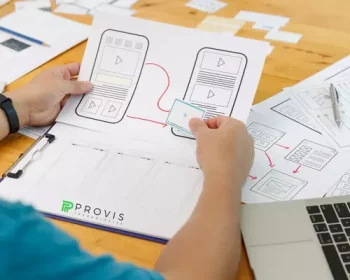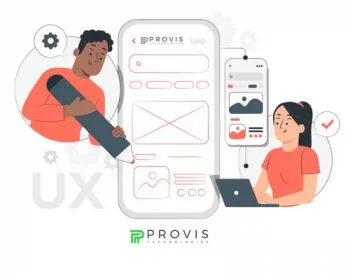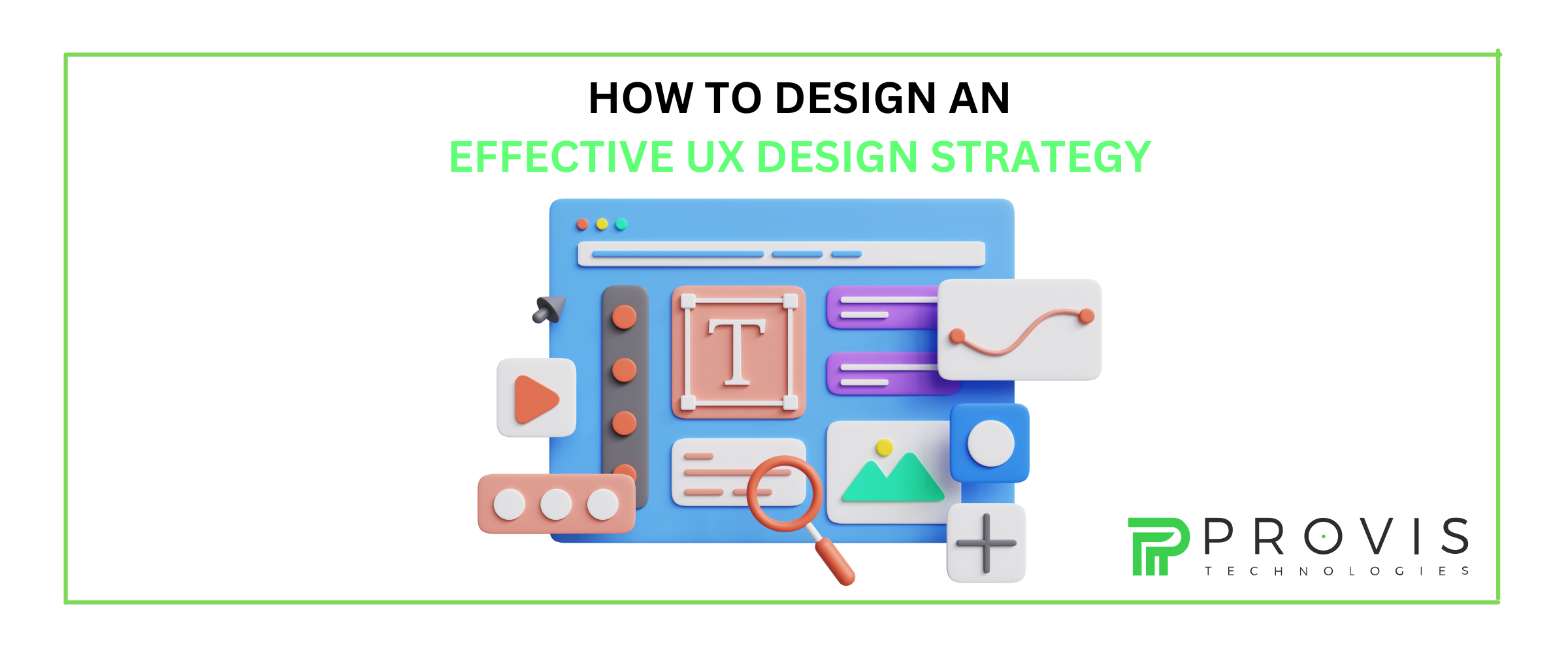The importance of the user experience is well-known. A great user experience leads to better business outcomes. A well-designed UX design strategy should be as important as an organization’s mission and vision.
A well-developed UX strategy is a roadmap to success and growth. Simultaneously, it provides a consistent and cohesive user experience to the users.
While designing a website or application, it is important to consider the customer’s point of view. Great brands are more than websites, logos, and apps and are completely focused on the user experience.
A bad UX strategy, of course, does not make for a good user experience.
Rather than a good UI, a rich UX increases website conversion rates rapidly.
Are you still perplexed by this term despite its popularity?

Also Read: How to Attract Visitors to Fall for Your Website?
What is UX design strategy, and how does it enhance the user experience?
Sometimes a message pops up on the screen while using the app about rating the experience or whether you like using the app, and without any doubt, you ignore that within a second.
User experience is not related to the internal and technical workings of the app, but it is all about the workings of the platform when a user interacts with it. A user experience is a detailed plan to position a company’s brand identity.
A UX design strategy helps guide teams in conceptualizing digital solutions.
You have to take time to create a UX strategy to reap its benefits in the long term.
UX means user experience, so it is important to consider the user’s preferences. The goal of an effective UX is to meet the user’s needs while remaining consistent with business requirements.
A UX strategy revolves around the user’s needs, business objectives, and brand identity. It is a roadmap for handling business objectives and end users’ perspectives.
It is a strategic planning process that aims to align the company’s primary objectives with the user’s needs.
Elements of UX design strategy
- Strategy – What is the motive behind creating the product, and what procedure will you follow? The search team researches who the end users are and their pain points.
- Scope – In scope, the designers understand the functional requirements and the features that will be added to the product. They finalize the idea and type of content that will be placed on the product.
- Structure – After finalizing the scope, next comes the structure. The architecture of the product is designed around this element. It involves the system’s functionality when users interact with a certain page.
- Skeleton – It involves presenting and arranging the previous and finalized information. Wireframes, prototypes, and the product’s information design are involved in this stage.
- Surface – It involves the final look and feel of the product. This stage comprises styling, visuals, color, and font. These points provide an understanding of navigating and interacting with the site.

Steps to Create a UX Design Strategy
-
Define your goals
The first step involves defining what you and your team are aiming for. Who is the target audience, and how can you reach them? Next, determine what your company’s goals and objectives are.
This stage entails determining where we are now, where we want to go, and how to get there.
Discussion with stakeholders is quite important regarding the company’s vision and mission.
The competitor’s research is also part of this step. But first, you must research whether the same product or service exists on the market. If yes, then how can you make yourself better?
The competitor’s analysis helps understand the market and the targeted group of customers. But, along with this, it is necessary to pay attention to the resources you have.
Before stepping onto the next step, focus on some questions –
- What do you want to create?
- What problem is your product solving?
- Key points of a successful UX design
- Budget
- Who are the targeted customers?
- Time constraints
-
Research
The word itself describes its importance. Therefore, moving on to the next step without conducting research can be misleading.
Once you have defined your goals, there is much to research about the new product’s design and market. Research is just as important as the other steps in a design strategy.
-
Stakeholders
How do you step further when you don’t have the required funding?
Stakeholders are the people who run the company and handle the project funding. Ensure that idea is strong enough to get the required amount of funding. The funding is based on how they find your product unique and what they foresee in the product. The greater the uniqueness, the higher the chances of creating an undying impression.
Also Read: Top 5 Color Palette Generators for Website Colors
-
Users
A comprehensive user base knowledge is required before proceeding further. Identify what your users liked about the previous product and how you can improve the new one.
Your goals and objectives are entirely dependent on the end users. Therefore, users’ requirements can greatly impact a product’s success. Try to research what information you already have about the users and what details you require.
-
Competitor
It is important to understand your competitors’ products and on what basis users like them. What features of the product are most liked by the end users? Look at the functionality and services provided by the competition.
Read the competitor’s reviews for a detailed understanding. Then, try to analyze how some features of competitors’ products are important for users.
-
Prepare the Outline
Now that you have understood the research and goal definition, it is time to implement the plan. First, it’s time to draft some designs, wireframes, and prototypes.
Start identifying the design software you need and the process you will use to keep your users’ needs at the forefront. While designing the outline, the points to consider are the features, content, and images you will include.
-
Testing
All the processing, struggles, planning, and research end here. This is the stage at which you will plan how to test the designs.
Testing aids in identifying errors and what stands in the way of a seamless user experience.
-
Evaluate the Results
Technology and trends change with time. Whether the feedback is negative or positive, create a detailed analysis of the user feedback. Then, try to improve the product and add new changes.
Consider the user’s needs. Then, work on the advanced version and the points to improve the existing design. Of course, sometimes your new features might be ignored, and sometimes users don’t like them, but that’s fine, as different users have different perspectives.
To sum up –
We are well familiar with the continuous changes in trends and technology. Every day, a new technology emerges, rendering the previous one obsolete. With these changes, achieving user satisfaction seems to be a long and difficult task.
However a well-designed UX strategy is a roadmap to success. A creative UX design strategy helps in generating revenue and minimizing unnecessary costs. A good UX strategy focuses on growth and success while considering the user’s needs.
Creating a great UX strategy and matching it with business objectives is quite difficult. But with Provis Technologies, a creative UX is guaranteed. With a team of skilled developers, we bring out unique solutions.
At Provis Technologies, our developers craft appealing UI and UX designs depending on the client’s requirements. A visually amazing and user-friendly design can accelerate your business’ growth, and our developers are quite proficient in this field.
Written By
Author's Picks
- Top Ways to Succeed in E-commerce How should you establish successful e-commerce for your offline business?
- 01/03/2024
- Best Web Development Tools For 2023
- 08/07/2023
- The Role of APIs in Modern Web Development: Connecting the Digital World
- 29/09/2024
Categories
- AI for Startups
- AI in Web Development
- AI Integration
- AI Platforms
- AI Prompt
- AI Tools
- AI Trading Software
- Android App
- Android vs iOS Development
- Angular
- API
- API Development
- App
- app development
- App Idea
- App User Feedback
- Application
- Artificial Intelligence
- Audit Services
- Automotive Industry
- Awards and Recognition
- Business Consulting
- Business Website
- Chatbots
- CRM
- CRM for Financial Advisors
- Custom CRM
- Custom SaaS
- Custom Website
- Customer Service
- dashboard design
- Developing a Mobile App
- Digital Business
- E-commerce
- EMR Integration
- Finance
- Financial Advisors
- Financial Advisors
- GIT
- Health Insurance
- iOS App
- iOS App Development
- IoT Mobile App Development
- IoT Platforms
- IT Audit Services
- IT Consulting
- IT Strategies
- Java Development
- Laravel
- Lean Canvas
- Learning Management System
- Logistics Apps
- Mobile App Development
- MVP
- Native App
- News Aggregator Site
- OTT
- Outsourcing IT
- Payment Gateway
- predictive analysis
- Product Launch Strategy
- Progressive Web App (PWA)
- Prototype
- Recommender Systems
- Ruby
- SaaS
- SaaS Application
- SaaS Business
- SaaS Company
- SaaS Development
- SaaS Product
- SaaS Project
- Sales Funnel
- SEO
- Shopping Cart
- Software Development
- SSL and TLS
- Startup Checklist
- Technology
- Tetradic Color Scheme
- UI/UX Design Company
- Unit Testing
- User Flow
- User Testing
- Web Development
- Web Performance Optimization
- website Maintenance Services
- Website Migration Service
- Website Speed Optimization
- WooCommerce
- WordPress





